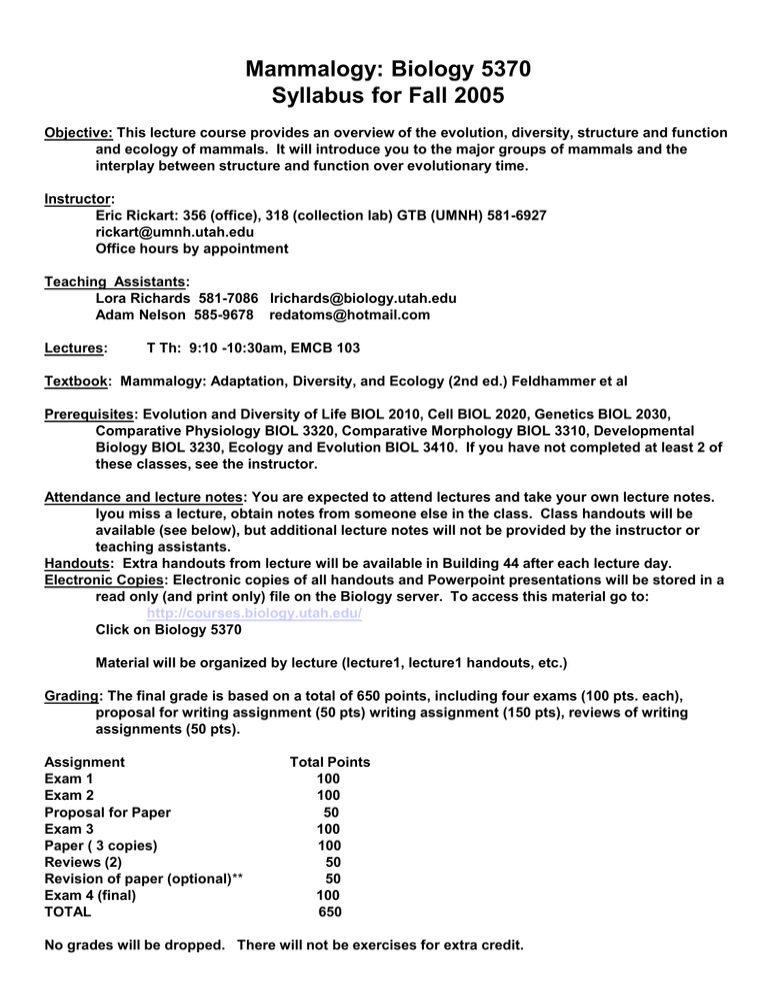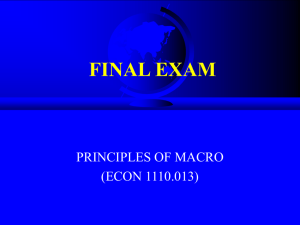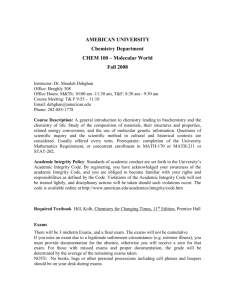Mammalogy: Biology 5370 Syllabus for Fall 2005
advertisement

Mammalogy: Biology 5370 Syllabus for Fall 2005 Objective: This lecture course provides an overview of the evolution, diversity, structure and function and ecology of mammals. It will introduce you to the major groups of mammals and the interplay between structure and function over evolutionary time. Instructor: Eric Rickart: 356 (office), 318 (collection lab) GTB (UMNH) 581-6927 rickart@umnh.utah.edu Office hours by appointment Teaching Assistants: Lora Richards 581-7086 lrichards@biology.utah.edu Adam Nelson 585-9678 redatoms@hotmail.com Lectures: T Th: 9:10 -10:30am, EMCB 103 Textbook: Mammalogy: Adaptation, Diversity, and Ecology (2nd ed.) Feldhammer et al Prerequisites: Evolution and Diversity of Life BIOL 2010, Cell BIOL 2020, Genetics BIOL 2030, Comparative Physiology BIOL 3320, Comparative Morphology BIOL 3310, Developmental Biology BIOL 3230, Ecology and Evolution BIOL 3410. If you have not completed at least 2 of these classes, see the instructor. Attendance and lecture notes: You are expected to attend lectures and take your own lecture notes. Iyou miss a lecture, obtain notes from someone else in the class. Class handouts will be available (see below), but additional lecture notes will not be provided by the instructor or teaching assistants. Handouts: Extra handouts from lecture will be available in Building 44 after each lecture day. Electronic Copies: Electronic copies of all handouts and Powerpoint presentations will be stored in a read only (and print only) file on the Biology server. To access this material go to: http://courses.biology.utah.edu/ Click on Biology 5370 Material will be organized by lecture (lecture1, lecture1 handouts, etc.) Grading: The final grade is based on a total of 650 points, including four exams (100 pts. each), proposal for writing assignment (50 pts) writing assignment (150 pts), reviews of writing assignments (50 pts). Assignment Exam 1 Exam 2 Proposal for Paper Exam 3 Paper ( 3 copies) Reviews (2) Revision of paper (optional)** Exam 4 (final) TOTAL Total Points 100 100 50 100 100 50 50 100 650 No grades will be dropped. There will not be exercises for extra credit. Exams will be based on lecture material. The best study guide for the exams will be your own lecture notes. Exams will include short essay, data analysis, multiple choice, and problemsolving questions. The last exam will be given during finals week, but it will be a regular exam. There will be not a comprehensive final. Exams will be graded as quickly as possible and returned to you in class. Exam keys will also be posted in Building 44. Exams that are not picked up in class will be available in Building 44. There will be no makeup exams. In the event of a true emergency you will need to OBTAIN WRITTEN, VERIFIABLE DOCUMENTATION of the emergency and contact the instructors as soon as you are able and we will try to work something out with you. Writing Assignment: There will be a single writing assignment for the class that will include a written proposal (50 pts), first submission (100 pts), and a final submission (50 pts). Each student will anonymously review the writing assignments of 2 other students (25 pts each). The writing assignment will be a review paper on a topic of your choice. More details will be given in class. Regrading: Questions regarding exam grades will be considered ONLY if received in writing, within one week of the day on which exams are returned to class. Requests should be directed to the teaching assistants. Course Drop Policy: The withdrawal policy is the same as the University of Utah policy described in the Class Schedule. Friday Sept. 2nd is the last day to drop with no tuition and no notation on the transcript. Tuesday Sept. 6th is the last day students can elect the CR/NC or audit option. Friday Oct. 21st is the last day students can withdraw, but tuition will be assessed and you will receive a W on your transcript. Verify with the registrar as these dates are subject to change. Withdrawal from the course after Oct. 21st requires special permission from the instructor. It will NOT be allowed except in cases of significant medical or personal emergency that must be documented by a medical professional or other relevant person. Americans with Disabilities Act (ADA): In accordance with University policy with respect to ADA matters and students with other identifiable disabilities, we will provide additional examination time as needed and appropriate. Students with such needs should identify themselves to the course instructor at least one week in advance of the first examination. Additionally you must provide a written statement of how we can assist you in completing course requirements. Students requiring additional time with teaching assistants are encouraged to attend as many discussion sections as needed and also to arrange to meet with the teaching assistants or instructor during office hours. Classification of Recent Mammals to ordinal level Class MAMMALIA Subclass - PROTOTHERIA Order - Monotremata - echidnas and platypus; 3 species Subclass - THERIA Infraclass Metatheria (Marsupials) Order Didelphimorphia - opossums; 63 species Order Paucituberculata - rat oppossums; 5 species Order Microbiotheria - Monito del Monte, Ilaca; 1 species Order Dasyuromorphia - extinct Tasmanian wolf, numbat, dasyures etc.; 63 sp. Order Peramelemorphia - bandicoots; 21 species Order Notoryctemorphia - marsupial "mole"; 2 species Order Diprotodontia - koala, wombats, kangaroos; possums; 117 species Infraclass Eutheria (Placentalia) Order Xenarthra – sloths, armadillos, anteaters; 29 species Order Pholidota - pangolins; 7 species Order Insectivora - shrews, tenrecs, moles, hedgehogs; 428 species Order Scandentia - tree shrews; 19 species Order Dermoptera - Colugos; 2 species Order Chiroptera - Bats; 925 species Order Primates - lemurs, monkeys and apes; 233 species Order Carnivora - cats, dogs, bears, seals, raccoons etc.; 271 species Order Cetacea - whales and dolphins; 78 species Order Sirenia - dugongs and manatees; 5 species Order Proboscidea - elephants; 2 species Order Hyracoidea - hyraxes; 6 species Order Perissodactyla - horses, tapirs & rhinos; 18 species Order Tubulidentata - Aardvark; 1 species Order Artiodactyla - pigs, hippos, camels, bovids, antelopes, deer; 220 sp. Order Macroscelidea - elephant shrews; 15 species Order Rodentia - rodents; 2021 species Order Lagomorpha - hares, rabbits and pikas; 80 species Total (in 1993) 4629 species of Recent mammals Wilson, D. L. & D. M. Reeder. 1993. Mammal Species of the World. Smithsonian Press Some common misconceptions Mammals are “modern” Mammals are “most advanced” Mammals are “dominant” First hominids Diversification of modern mammals Extinction of dinosaurs Earliest mammals & earliest dinosaurs Earliest therapsids Earliest pelycosaurs Earliest amniotes Earliest amhpibians Jawed fish Earliest vertebrates Cladistics (Phylogenetic Systematics) – An objective method of determining evolutionary relationships of organisms (phylogeny), based on comparative analysis of characters (morphological, genetic, behavioral, etc). Basic terminology: Phenetics – study of evolutionary relationships based on overall similarity Cladistics – study of evolutionary relationships based on derived similarity Character (or trait) – any discrete feature or attribute that exhibits variation Character state – expression of a particular character (e.g., presence, absence) In group – group of organisms being studied Out group – related group outside that being studied (used as a point of reference to determine character polarity) Character polarity – direction of evolutionary change in a character Primitive character (plesiomorphy) – character state is primitive or “generalized” (shared by both the ingroup and outgroup) Derived character (apomorphy) – character state is advanced or “specialized” (differs from the outgroup) Synapomorphy (shared derived trait) – derived trait shared by 2 or more groups Cladogram -- a graphical representation of evolutionary relationships Monophyletic group (clade, or “natural group”) – a group of sharing a common ancestor. Represents a complete evolutionary lineage. Polyphyletic -- group with more than one ancestor; an “artificial” group. Paraphyletic -- group that does not contain all descendants of a common ancestor; an incomplete group Node – branching point on a cladogram Sister –groups – groups on either side of a node (i.e., closest relatives) Monophyletic groups Polyphyletic Paraphyletic VERTEBRATA GNATHOSTOMA TETRAPODA AMNIOTA SAUROPSIDA CLASSIFICATION OF AMNIOTES TRADITIONAL PHYLOGENETIC AMNIOTE RELATIONSHIPS . Synapsida AMNIOTE RELATIONSHIPS Ancestral amniote skull types ANAPSID “stem reptiles” turtles EURYAPSID Extinct marine reptiles SYNAPSID DIAPSID Archosaurs Lizards & Snakes Amniote skulls SYNAPSIDS M Q Ar An D Dimetrodon Titanophoneus Synapsid evolution Synapsid evolution Mammals Pelycosaurs “primitive” mammal-like reptiles ORDER PELYCOSAURIA Ophiacodonts mid Pennsylvanian – early Permian Varanopseids Permian Caseids Permian Edaphosaurs late Pennsylvanian – early Permian Sphenacodonts late Pennsylvanian – mid Permian Pelycosaur cladogram Dimetrodon







